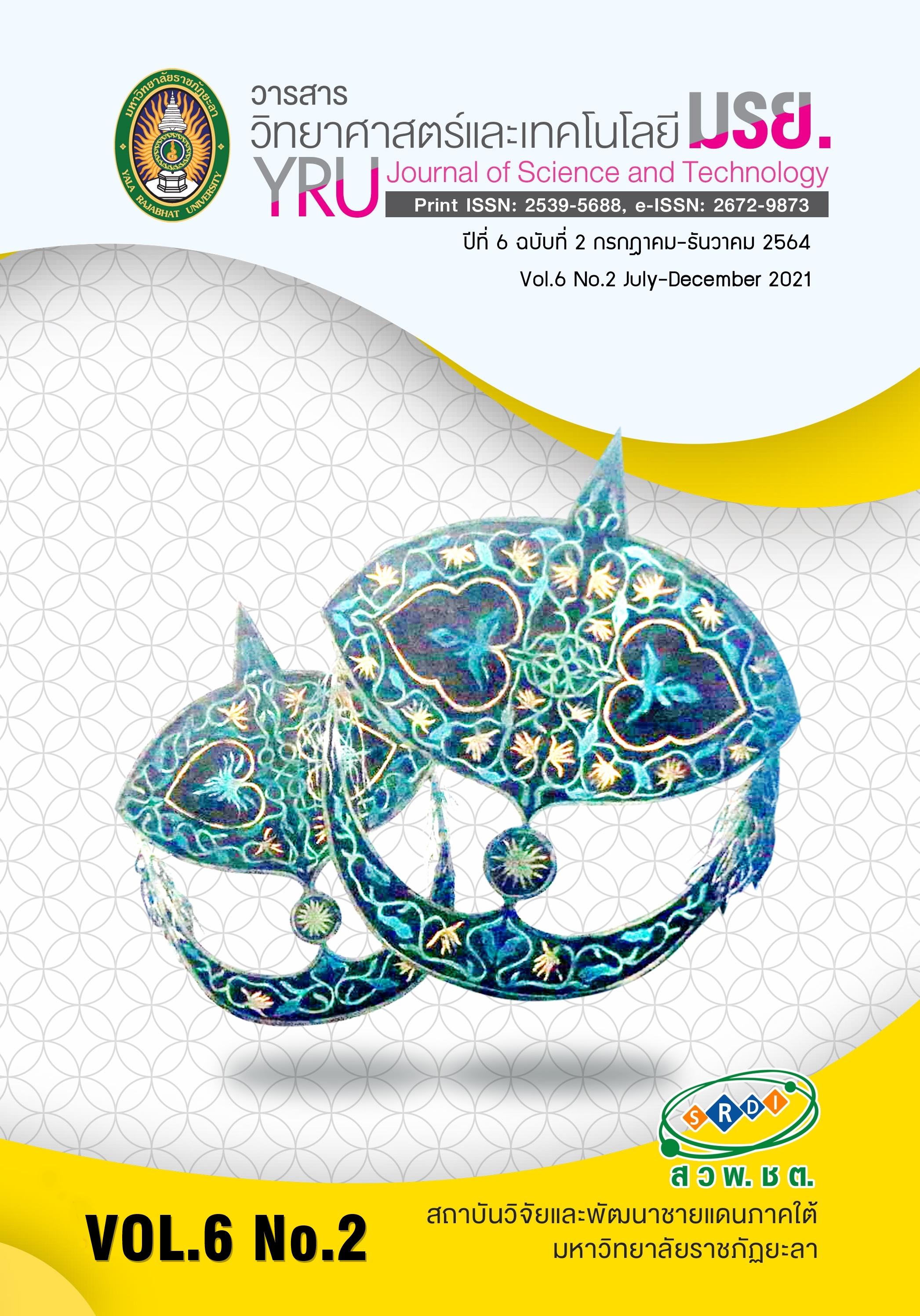ผลของไซโตไคนินและการเตรียมชิ้นส่วนต่อการทวีจำนวนต้นกล้วยไข่สายพันธุ์กำแพงเพชร ในสภาพปลอดเชื้อ
Main Article Content
บทคัดย่อ
จากการเลี้ยงเนื้อเยื่อเพื่อขยายพันธุ์กล้วยไข่สายพันธุ์กำแพงเพชรที่ยังคงประสบปัญหาอัตราการทวีจำนวนยอดต่ำจึงได้ศึกษาการผ่าแบ่งชิ้นส่วนร่วมกับไซโตไคนินต่อการทวีจำนวนยอดใหม่ โดยเลี้ยงชิ้นส่วนหน่อที่ผ่าแบ่งตามยาวเป็น 2 ส่วน บนอาหารแข็งสูตร MS ที่เติมน้ำตาล 30 กรัมต่อลิตร และเติมไซโตไคนิน ได้แก่ Benzyladenine (BA), Kinetin (Kn) และ Thidiazuron (TDZ) ความเข้มข้น 0, 0.5, 1.0, 2.0 และ 4.0 มิลลิกรัมต่อลิตร เป็นเวลา 6 สัปดาห์ วางแผนการทดลองแบบสุ่มตลอด พบว่า ชิ้นส่วนที่เลี้ยงบนอาหารสูตรที่เติม TDZ 0.1 มิลลิกรัมต่อลิตร ให้จำนวนยอดใหม่เฉลี่ยสูงสุด 2.6 ยอด เมื่อเลี้ยงชิ้นส่วนที่ผ่าแบ่งเป็น 2 และ 4 ส่วน บนอาหารสูตรที่เติม TDZ ความเข้มข้น 0, 0.5, 1.0, 2.0 และ 4.0 มิลลิกรัมต่อลิตร นาน 12 สัปดาห์ พบว่า ชิ้นส่วนผ่าแบ่ง 2 ส่วน ให้จำนวนยอดใหม่มากกว่าชิ้นส่วนผ่าแบ่ง 4 ส่วน ให้จำนวนยอดสูงสุดเฉลี่ย 5.2 ยอด เมื่อเลี้ยงบนอาหารสูตรที่เติม TDZ 2.0 มิลลิกรัมต่อลิตร เมื่อย้ายเลี้ยงยอดใหม่บนอาหารสูตรที่เติมออกซิน Indole-3-acetic acid (IAA), Indole-3-butyric acid (IBA) และ Naphthaleneacetic acid (NAA) ความเข้มข้น 0, 0.5, 1.0, 2.0 และ 4.0 มิลลิกรัมต่อลิตร นาน 6 สัปดาห์ พบว่าต้นอ่อนเกิดรากมากที่สุดเฉลี่ย 19.9 ราก เมื่อเลี้ยงบนอาหารสูตร ที่เติม IAA 2.0 มิลลิกรัมต่อลิตร และต้นกล้าที่ได้จากอาหารที่เติมออกซินทุกสูตรนั้น มีอัตราการรอดชีวิต 100% เจริญดี ในโรงเรือนเพาะชำ การศึกษานี้ประสบความสำเร็จในการเพิ่มจำนวนยอดใหม่กล้วยไข่สายพันธุ์กำแพงเพชร และการย้ายต้นออกปลูกในเรือนเพาะชำมีการเจริญเติบโตเป็นอย่างดี
Article Details
บทความ ข้อมูล เนื้อหา รูปภาพ ฯลฯ ที่ได้รับการเผยแพร่ในวารสารวิทยาศาสตร์และเทคโนโลยี มรย. นี้ ถือเป็นลิขสิทธิ์ของวารสารวิทยาศาสตร์และเทคโนโลยี มรย. หากบุคคลหรือหน่วยงานใดต้องการนำทั้งหมดหรือส่วนหนึ่งส่วนใดไปเผยแพร่ต่อหรือกระทำการใดๆ จะต้องได้รับอนุญาตเป็นลายลักษณ์อักษรจากวารสารวิทยาศาสตร์และเทคโนโลยี มรย. ก่อนเท่านั้น
เอกสารอ้างอิง
George, E. F., Hall, M. A. & Klerk, G. J. D. (2008). Plant Growth Regulators II: Cytokinins, their Analogues and Antagonists. In E. F. George, M. A. Hall, & G. J. D. Klerk (Eds.), Plant Propagation by Tissue Culture (3rd ed., pp. 205-226). Dordrecht: Springer.
Guo, B., Abbasi, B. H., Zeb, A., Xu, L. L. & Wei. Y. H. (2011). Thidiazuron: A Multi-Dimensional Plant Growth Regulator. African Journal of Biotechnology, 10(45), 8984-9000.
Heedchim, W. & Te-chato, S. (2017). Effects of Explant Preparations and Concentrations of BA on Multiple Shoot Formation of Banana (Musa acuminata “Cavendish”) In Vitro. Songklanakarin Journal of Plant Science, 4(2), 6-12. (in Thai)
Huetteman, C. A. & Preece, J. E. (1993). Thidiazuron: A Potent Cytokinin for Woody Plant Tissue Culture. Plant Cell, Tissue and Organ Culture, 33, 105-119.
Kantard, P. (2011). Research Study on the Production of Kluay Hom Thong through Shoot tip Cutting. Retrieved from https://erp.mju.ac.th/openFile.aspx?id=Mzg2ODc= (in Thai)
Khatab, I. A. & Youssef, M. S. (2018). Micropropagation and Assessment of Genetic Stability of Musa sp. cv. Williams Using RAPD and SRAP Markers. Egyptian Journal of Botany, 58(3), 1-10.
Muangkaewngam, A. (2014). Micropropagation of Saba (Musa sapientum Lin.) In Vitro through Shoot Tip Culture. Songklanakarin Journal of Plant Science, 1(3), 24-27. (in Thai)
Muengsombut, W. (2011). Effect of Thidiazuron (TDZ) on In Vitro Shoot Proliferation in Namwa Bananas. (Undergraduate Special problem). Kasetsart University, Kampangsaen. (in Thai)
Murashige, T. & Skoog, F. (1962). A Revised Medium for Rapid Growth and BioAssays with Tobacco Tissue Cultures. Physiologia Plantarum, 15, 473-497.
Murthy, B. N. S., Murch, S. J. & Saxena P. K. (1998). Thidiazuron: A Potent Regulator of In Vitro Plant Morphogenesis. In Vitro Cellular & Developmental Biology – Plant, 34, 267-275.
Prabhuling, G. & Sathyanarayana, B. N. (2017). Liquid Medium Culture Method for Rapid Multiplication of Banana (Musa acuminata) cv. ‘Grand Naine’ Through Tissue Culture. International Journal of Plant Sciences, 12(1), 85-89.
Pradhan, B. & Deo, B. (2019). Detection of Phytochemicals and In Vitro Propagation of Banana (Musa variety Gaja Bantal). Journal of Medicinal Plant Studies, 7(1), 46-49.
Silayoi, B. (1995). Banana. (2nd ed.). Bangkok: Kasetsart University. (in Thai)
Silayoi, B. (2001). Micropropagation of Kluai Khai (Musa acuminata ‘Klaui Khai’) Using Sword Suckers and Inflorescences at Various Development Stages. Kasetsart Journal: Natural Science, 35, 361–367.
Smitha, P. D., Binoy, K. R. & Nair, A. S. (2014). Effect of TDZ on Direct Shoot Regeneration from Whole Male Inflorescence of Four Diploid Banana Cultivars from South India. Plant Science International, 1, 24-32.
Wiriyananont, Y., Vangmul, P. & Ramasoot, S. (2019). Effect of Culture Media and Bud Splitting on Development of Banana (Musa sp. cv. Namwa (ABB) from In Vitro Shoot Bud Culture. Wichcha Journal Nakhon Si Thammarat Rajabhat University, 38(1), 16-27. (in Thai)
Yusnita, Y., Danial, E. & Hapsoro, E. (2015). In Vitro Shoot Regeneration of Indonesian Bananas (Musa spp.) cv. Ambon Kuning and Raja Bulu, Plantlet Acclimatization and Field Performance. Agrivita, 37(1), 51-58.
Zhu, Y., Liu, K. S. & Yiu, J. C. (2005). Effect of Cutting Method on Bulb Production of Hippeastrum hybridum in Taiwan. Acta Horticulturae, 673, 531-535.


